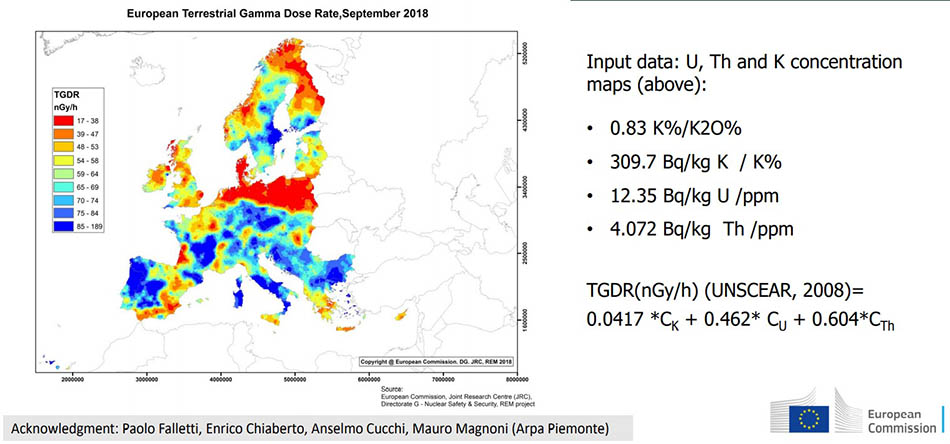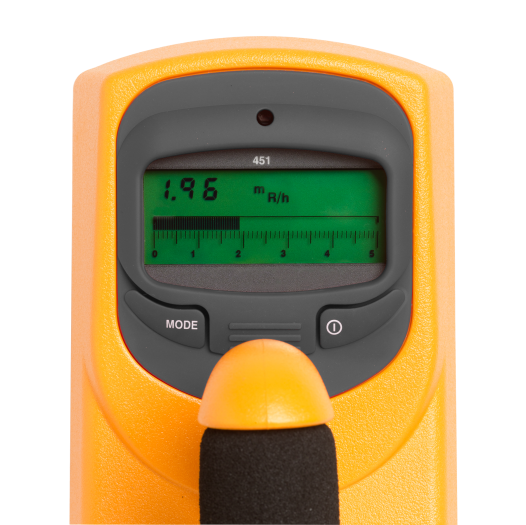
RADIOACTIVITY MEASUREMENTS (IONIZING RADIATION MEASUREMENTS)
Aktinovolia.com measures Ionizing radiation with Victoreen USA instruments certified for their effectiveness in detecting and accurately measuring radioactive radiation.
We measure ionizing radiation for every reason…
- Possible power plant leaks
- Potential contamination of imported products from suspected areas
- Measurements of Granites and Suspicious Materials
- Measurements of building iron aggregates, etc.
- Plot measurements for proper subsoil mapping
- Measurements of timber from suspected radioactive areas
- Measurements of radioactive in each case
Ionizing radiation is a radiation that carries energy capable of penetrating matter, causing ionization of its atoms, violently breaking chemical bonds, and causing biological damage to living organisms.
Atom ionization is a natural phenomenon that follows the interaction of high energy radiation with matter. It is the violent expulsion of an electron by the atom, resulting in the creation of a pair of oppositely charged ions.
The best known ionizing radiations are the X-rays produced in the lamps of radiological machines and widely used in medicine, as well as the radiations α, β, and γ emitted by unstable atom nuclei. Ionizing radiation is penetrating.

We measure Radioactivity - Ionizing Radiations in materials and environment with professional measuring instruments
Their penetration into matter depends on their type and the energy they carry. Particles "a" are cut from a sheet of paper, particles "b" from a few millimeters of plexiglass, while high-energy radiation "c" requires relatively large thicknesses of selected materials to be cut (eg pencil, concrete).
The amount of energy transferred from radiation to matter per kilogram of mass is called the radiation dose. The possibility of damage to health is directly related to the dose of the dose
Sources of ionizing radiation: Man during his life, receives radiation from a large set of natural and artificial sources that are scattered around him. Ionizing radiation depending on their emission source is divided into: Natural radiation (terrestrial and space environment) and Artificial which were invented and used by man.
Natural sources of radiation Natural sources are an integral part of the earth's environment and include the components of the earth's crust and cosmic radiation. The soil, water and air, among other things, contain natural radioactive elements, while the earth's surface is constantly affected by cosmic radiation with sources emitting the sun and other stellar regions immersed in space. The main component of natural radioactivity in terms of radiological effects on humans, is the natural radioactive gas radon, which comes from uranium present in the soil and rocks of the earth.
Artificial sources of radiation and their use by humans: Man discovered artificial sources of radiation production in the late 19th century. Since then, systematic research has led to both their widespread use and measures to protect against their potential harmful effects.
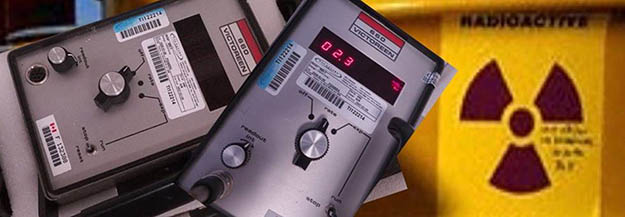
Radiations in use today:
in medicine with a contribution to diagnosis and treatment, in industry (radiographs, radiators for sterilization of materials, devices for quality control, various consumer goods, etc.) in energy production, agriculture, research and education.
To man-made sources of radiation must be added the environmental pollution caused by nuclear tests in the atmosphere before 1962 and certain nuclear accidents, such as the 1986 Chernobyl reactor.
Biological effects
Exposure to ionizing radiation can have immediate or long-term harmful effects on health.
For very high doses of radiation, exposure can be followed by immediate destruction of cells, organs and systems and can sometimes lead to death. Doses leading to immediate results were observed only in major radiological or nuclear accidents.
For relatively low doses, smaller than those that lead to immediate results, there is a statistical probability of future cancer, the measure of which is proportional to the dose. Of particular importance are those damage caused to the genetic material of the cell, because they are associated with both the transmission of inherited abnormalities to the offspring and the process of carcinogenesis. The acquired knowledge allows us to confidently include radiation in the 4000 and more recorded carcinogens - usually chemicals and pharmaceuticals of modern technology - that undermine our daily lives. On the risk scale, radiation is classified as a relatively mild carcinogen.

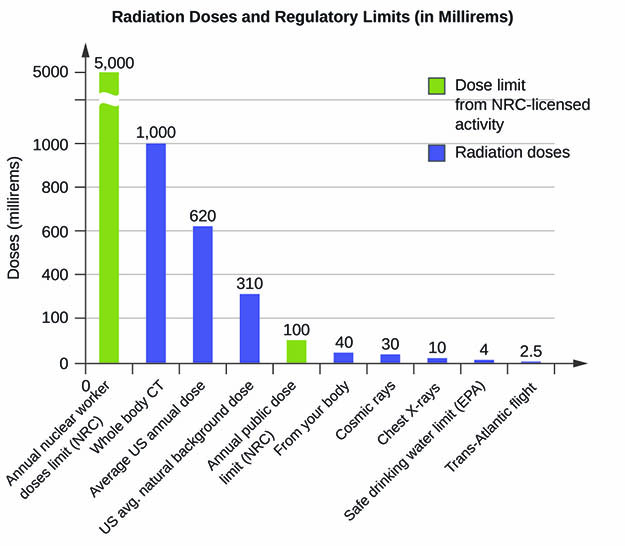
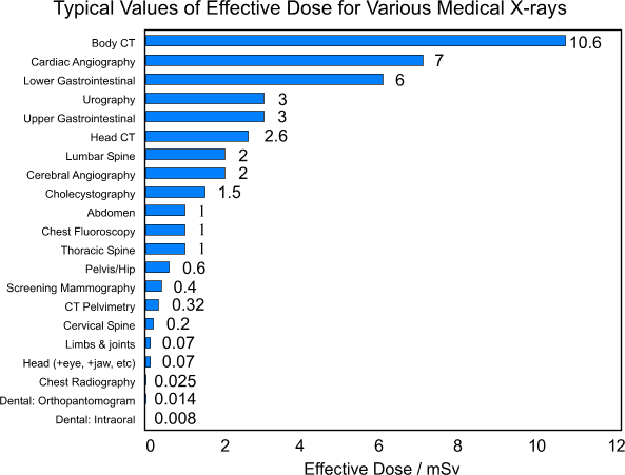
The UN Scientific Commission on the Effects of Atomic Radiation (UNSCEAR) currently uses the term low dose to mean absorbed levels below 100 mGy but greater than 10 mGy, and the term very low dose for any levels below 10 mGy. High absorbed dose is defined as more than about 1000 mGy. For beta and gamma radiation, these figures can be taken as mSv equivalent dose.
| Some comparative whole-body radiation doses and their effects | |
| 2.4 mSv/yr | Typical background radiation experienced by everyone (average 1.5 mSv in Australia, 3 mSv in North America). |
|---|---|
| 1.5 to 2.5 mSv/yr | Average dose to Australian uranium miners and US nuclear industry workers, above background and medical. |
| Up to 5 mSv/yr | Typical incremental dose for aircrew in middle latitudes. |
| 9 mSv/yr | Exposure by airline crew flying the New York – Tokyo polar route. |
| 10 mSv/yr | Maximum actual dose to Australian uranium miners. |
| 10 mSv | Effective dose from abdomen & pelvis CT scan. |
| 20 mSv/yr | Current limit (averaged) for nuclear industry employees and uranium miners in most countries. (In Japan: 5 mSv per three months for women) |
| 50 mSv/yr | Former routine limit for nuclear industry employees, now maximum allowable for a single year in most countries (average to be 20 mSv/yr max). It is also the dose rate which arises from natural background levels in several places in Iran, India and Europe. |
| 50 mSv | Allowable short-term dose for emergency workers (IAEA). |
| 100 mSv | Lowest annual level at which increase in cancer risk is evident (UNSCEAR). Above this, the probability of cancer occurrence (rather than the severity) is assumed to increase with dose. No harm has been demonstrated below this dose. Allowable short-term dose for emergency workers taking vital remedial actions (IAEA). Dose from four months on international space station orbiting 350 km up. |
| 130 mSv/yr | Long-term safe level for public after radiological incident, measured 1 m above contaminated ground, calculated from published hourly rate x 0.6. Risk too low to justify any action below this (IAEA). |
| 170 mSv/wk | 7-day provisionally safe level for public after radiological incident, measured 1 m above contaminated ground (IAEA). |
| 250 mSv | Allowable short-term dose for workers controlling the 2011 Fukushima accident, set as emergency limit elsewhere. |
| 250 mSv/yr | Natural background level at Ramsar in Iran, with no identified health effects (Some exposures reach 700 mSv/yr). Maximum allowable annual dose in emergency situations in Japan (NRA). |
| 350 mSv/lifetime | Criterion for relocating people after Chernobyl accident. |
| 500 mSv | Allowable short-term dose for emergency workers taking life-saving actions (IAEA). |
| 680 mSv/yr | Tolerance dose level allowable to 1955 (assuming gamma, X-ray and beta radiation). |
| 700 mSv/yr | Suggested threshold for maintaining evacuation after nuclear accident. (IAEA has 880 mSv/yr over one month as provisionally safe. |
| 800 mSv/yr | Highest level of natural background radiation recorded, on a Brazilian beach. |
| 1,000 mSv short-term | Assumed to be likely to cause a fatal cancer many years later in about 5 of every 100 persons exposed to it (i.e. if the normal incidence of fatal cancer were 25%, this dose would increase it to 30%). Highest reference level recommended by ICRP for rescue workers in emergency situation. |
| 1,000 mSv short-term | Threshold for causing (temporary) radiation sickness (Acute Radiation Syndrome) such as nausea and decreased white blood cell count, but not death. Above this, severity of illness increases with dose. |
| 5,000 mSv short-term | Would kill about half those receiving it as whole body dose within a month. (However, this is only twice a typical daily therapeutic dose applied to a very small area of the body over 4 to 6 weeks or so to kill malignant cells in cancer treatment.) |
| 10,000 mSv short-term | Fatal within a few weeks. |
The main expert body on radiation effects is the UN Scientific Commission on the Effects of Atomic Radiation (UNSCEAR), set up in 1955 and reporting to the UN General Assembly. It involves scientists from over 20 countries and publishes its findings in major reports. The UNSCEAR 2006 report dealt broadly with the Effects of Ionizing Radiation. Another valuable report, titled Low-level Radiation and its Implications for Fukushima Recovery, was published in June 2012 by the American Nuclear Society.

We measure Radioactivity - with Fluke Victoreen calibrated machines
How to assess the risk of damage to health after exposure to ionizing radiation
The dosage size associated with the risk involved for the long-term effects of radiation is the active dose. The active dose depends on the energy absorbed by the human body, the type of radiation and the type of tissue irradiated. The unit of measurement of the active dose is Sievert (Sv) and its multiples, mSv and μSv. The average active dose of an individual due to the artificial and natural sources of radioactivity of the earth's environment is 0.31 mSv and 2.4 mSv for each year respectively, while the active dose corresponding to a typical chest x-ray is about 0.02 mSv.
The most common reasons that lead to a measurement are:
◦ The determination of radiation levels in real estate for living, working or investing
◦ The detection of any radioactivity in building materials, objects from Japan, lenses etc.
. The detection of any Radon on low floors of buildings
◦ Health problems for which the cause has not been identified
. The control and licensing of X-ray machines in medical centers
. Radiation studies for the health and safety of employees in companies
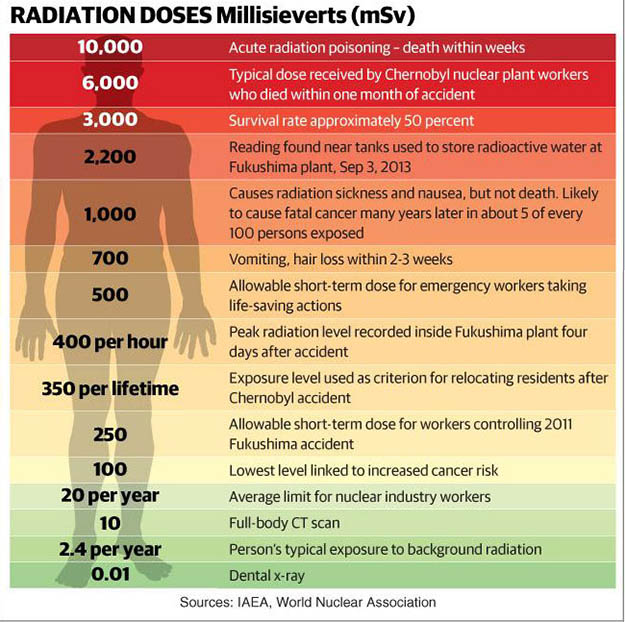
We detect Ionizing radiation with the most modern equipment ... we give you information of incalculable value for your life and your living space ...
And something from the Cold War ... Victorian radioactivity meters ... another world from the past.
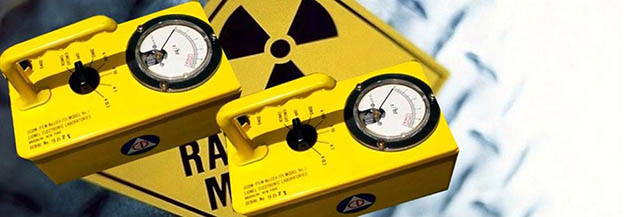
Check our Radon Gas measurement services
- - -
Radioactivity Information Links:
Ionizing Radiation and Radon in materials and environment


